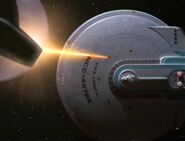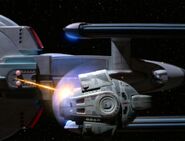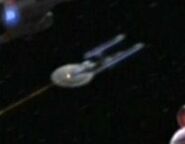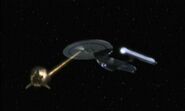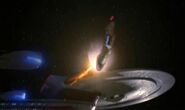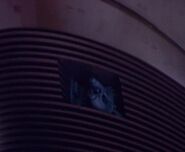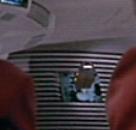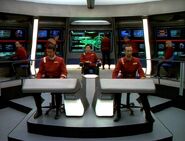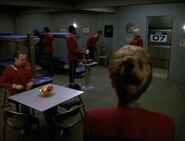![]() Translation in progress - Traduzione in corso
Translation in progress - Traduzione in corso
| Classe Excelsior Configurazione originale | |
|---|---|
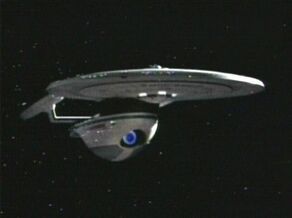 Vista frontale | |
| Affiliazione: | Federazione - Flotta Stellare |
| Attività: | Anni 2280 - Anni 2370 |
| Ponti: | 34 |
| Armamento: | Phaser, siluri fotonici |
| Difese: | Scudi deflettori |
| Classe Excelsior Configurazione aggiornata | |
|---|---|
 Vista frontale | |
| Affiliazione: | Federazione - Flotta Stellare |
| Attività: | Anni 2290 - Anni 2370 |
| Ponti: | 34 |
| Armamento: | Phaser, siluri fotonici |
| Difese: | Scudi deflettori |
La classe Excelsior è un tipo di nave stellare della Federazione utilizzata dalla Flotta Stellare dalla fine del XXIII secolo fino al tardo XXIV secolo. Fu la spina dorsale della Flotta Stellare per quasi un secolo, il che la rende una delle classi più longeve e una di quelle dal design più ricnoscibile tra le navi della Flotta.
Storia[]
Le navi di classe Excelsior furono inizialmente costruite durante gli anni 80 del XXIII secolo presso Cantieri Navali di San Francisco, in orbita attorno alla Terra. (Star Trek VI: Rotta verso l'ignoto targa di dedica)
La Flotta Stellare nutriva grandi speranze per la prima nave di questa classe, il prototipo USS Excelsior, era dotato di un motore a transcurvatura, e fu considerato come "l'esperimento del secolo." (Star Trek III: Alla ricerca di Spock)
- Guardare: Viaggio di prova della USS Excelsior per informazioni più dettagliate.
Nonostante il fallimento del "Grande esperimento", la Flotta Stellare continuò ad impiegare i progetti della Excelsior. Il prototipo rimase presso l'Hangar spaziale terrestre almeno fino al 2287, successivamente fu destinato al servizio attivo nel 2290. (Star Trek IV: Rotta verso la Terra, Star Trek V: L'ultima frontiera, Star Trek VI: Rotta verso l'ignoto)
Nel 2293, il destino del progetto fu segnato quando la Flotta Stellare ................ name of a legacy. Il lancio dell'USS Enterprise-B riaprì le porte al progetto delle Excelsior, per diventare una delle classi più utilizzate dalla Flotta Stellare, una classe che durò fino alla fine del XIV secolo. (Star Trek VI: Rotta verso l'ignoto; Star Trek Generazioni; TNG: "Incontro a Farpoint" – VOY: "La fine del gioco")

Alongside a Classe Galaxy starship
Once fully integrated into the fleet, the Excelsior's sister ships were used for a variety of mission profiles, ranging from deep space exploration and terraforming missions, to patrol duty, to courier and transport runs. (Star Trek VI: Rotta verso l'ignoto; TNG: "Tin Man", "The Drumhead", "Brothers", "Allegiance"; DS9: "Homefront", "For the Uniform", etc.) The Excelsior-class was also frequently used by the Starfleet flag officers for use as a personal flagship. (TNG: "The Offspring", "The Best of Both Worlds", "Chain of Command, Part I", "Descent", "Preemptive Strike")
The Excelsior-class was present in several major Federation engagements, including the Borg invasion of 2366-2367, where it participated at the Battle of Wolf 359, as well as the engagement against the Borg sphere that entered the Sol system in 2378. (DS9: "Emissary"; VOY: "Unity", "Endgame") They were also present in numerous Dominion War battles, seeing action during Operation Return, the First and Second Battles of Chin'toka, and the Battle of Cardassia. Many Excelsior-class vessels were stationed on the front lines near Deep Space 9 during the war. (DS9: "Sacrifice of Angels", "Tears of the Prophets", "The Changing Face of Evil", "What You Leave Behind", etc.)
Details of this class would be retained well into the 31st century, when Captain Jonathan Archer and Lieutenant Malcolm Reed viewed schematics on the class in the 22nd century while accessing the database belonging to temporal agent Daniels. (ENT: "Shockwave")
Dati tecnici[]
Struttura[]
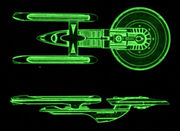
Profile and overview of the Excelsior
The Excelsior-class featured the saucer section-engineering section-warp nacelle layout common to most Starfleet vessels. However, it featured a more streamlined design than was seen in previous classes.
Port-side docking port
Design features of the primary hull included a docking port located on the port side of the hull. (DS9: "Crisalide")
Aggiornamenti al design[]
Following its initial, and somewhat unsuccessful origins, the Excelsior underwent a minor refit, which included a new bridge module, in addition to a significant modification to the aft portion of the saucer section, surrounding the impulse drive, and a modification to the cargo bay on the aft ventral portion of the ship. This configuration would remain the standard for the Excelsior-class throughout its service. (Star Trek VI: Rotta verso l'ignoto)

The USS Enterprise-B, featuring additional impulse engines (top) and additional scoop surrounding the deflector dish (bottom)
In less than a decade, the Excelsior design underwent a second, more significant overhaul, as introduced with the launch of the Enterprise-B. While remaining true to the original design, this new configuration added several modifications to the basic hull, including the addition of a second pair of impulse engines, an expanded scoop surrounding the deflector dish, and the addition and removal of a number of fins located on the saucer and nacelles. (Star Trek Generazioni; DS9: "Paradise Lost")
As this class aged, Starfleet continued to incorporate the latest technology, through continued upgrades, refits and repairs, well into the 2360s and 2370s. In 2364, the USS Melbourne underwent significant repairs at Starbase 74, while in 2367 the USS Hood underwent a major system upgrade at Starbase 174. (TNG: "11001001", "Fratelli", etc.)
Sistemi tattici[]
The original Excelsior design was outfitted type 8 phaser emitters in five dual phaser emplacements on the forward saucer section, and one dual emplacement on the aft of the saucer. Phaser banks were also positioned laterally, located port and starboard, near the point that the primary and secondary hulls meet, as well as one emplacement located between the nacelles. (Star Trek VI: Rotta verso l'ignoto; Star Trek Generazioni production art; DS9: "Paradiso perduto", etc.)
In addition, the Excelsior was equipped with several photon torpedo launchers. The two primary launchers were located in the forward section, on both sides of the deflector dish seen as two dark colored ports ahead of the starfleet hull banners. The upper forward launchers were located on the neck section, also allowing ship access for cargo management units. Aft launchers were located above the main shuttlebay. (Star Trek Generazioni production art) In addition, the shields were stronger than the Classe Constitution refit, capable of withstanding a direct photon torpedo strike without suffering any visible damage to the outer hull. (Star Trek VI: Rotta verso l'ignoto)
With the impending threat of the Dominion against the Federation, Starfleet began to experiment, in 2372, with performing a refit on the Excelsior-class USS Lakota. Upgrades included improved phaser emplacements, quantum torpedoes, and other improvements to make the ship competitive with such ship designs as the Classe Defiant. (DS9: "Paradiso perduto")
Sistemi di propulsione[]
Velocità di transcurvatura – in teoria
Initially the Excelsior was designed under a radically new principle in propulsion, the transwarp drive. While an awe-inspiring concept to some, it was the traditional engineers who remained skeptical of this new form of warp drive. (Star Trek III: Alla ricerca di Spock) Following this failure, the Excelsior spent the next two years in spacedock before being fitted with a traditional warp drive. (Star Trek IV: Rotta verso la Terra; Star Trek V: L'ultima frontiera; Star Trek VI: Rotta verso l'ignoto)
By the early 24th century, Excelsior-class vessels were normally equipped with dilithium recompositing and recrystallization technology. The theta-matrix compositor of the time, which later became outdated, was upgraded by the time the Classe Galaxy was introduced. This new recrystallization process was ten times more efficient than that of the Excelsior-class. (TNG: "Family")
The Excelsior-class also used micro-power relays in its warp core matrix compositor. (DS9: "For the Uniform")
Design interno[]
- See: Excelsior-class decks, for deck configuration.
Plancia[]
The main viewscreen (2293)
Located on top of the primary hull, the Excelsior's main bridge directly supervised all primary mission operations and coordinated all departmental activities. Due to the age and variety of configurations of the Excelsior-class, bridge configurations varied from ship to ship.
Against the aft wall of many Excelsior bridges was the large engineering master systems display monitor, showing a cutaway of the ship and status information. This was not originally part of the USS Excelsior configuration but added later, a feature shared with sister ship USS Enterprise-B. (Star Trek III: Alla ricerca di Spock; Star Trek VI: Rotta verso l'ignoto; Star Trek Generazioni; VOY: "Flashback")
Sanders transmitting from the bridge of the Malinche
At least one Excelsior-class starship, the USS Malinche, had a holo-communicator installed in its main bridge in 2373. Upon first use of the technology, Malinche Captain Sanders described to Captain Benjamin Sisko, who was on the transmitting end on board the USS Defiant, "you appear to be sitting on my bridge. It may take me a while to get used to this." (DS9: "Per l'uniforme")
Sala di manovra[]
The captain's ready room was located adjacent to the bridge, and contained a desk and chair, along with a personal viewer, and was backed by several LCARS interfaces and an MSD. (TNG: "Unnatural Selection", "Tin Man"; DS9: "Paradiso perduto")
Ensign Nog of Deep Space 9 once explained to Chief O'Brien how Al Lorenzo liked to sneak into famous starship captain's offices and take holophotos of himself sitting behind their desks. Included in Lorenzo's collection was a holophoto of himself sitting behind Captain DeSoto's desk on board the Hood. (DS9: "Treachery, Faith and the Great River")
Sala deflettore[]

Access way to the deflector room
The deflector room, located on Deck 15, Section 21-alpha, was positioned directly behind the Excelsior's deflector dish. It was a small control room that could be accessed by a series of catwalks and ladders. The deflector room housed several consoles, in addition to the ship's deflector relays. (Star Trek Generazioni)
[]
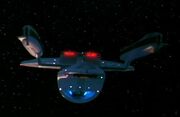
Aft view, including shuttle and cargo bays in intense blue light
The Excelsior-class contained several cargo bays, including one located in the aft dorsal section of the secondary hull as well as several bays located along the ventral section of the secondary hull. (Star Trek Generazioni production art) The main shuttlebay was located in the stern by the landing bay doors, which housed several shuttles of different types, including the type 7 shuttlecraft. (TNG: "The Child")
Alloggi[]
Senior officers, such as the captain, had private quarters below decks. Captain Hikaru Sulu's quarters were located on Deck 3.
Many of the enlisted crew, junior officers and officers shared quarters and bunk areas. They varied in occupant size from four to nine. (Star Trek VI: Rotta verso l'ignoto; VOY: "Flashback")
[]
- Named
- USS Berlin (NCC-14232)
- USS Cairo
- USS Charleston (NCC-42285)
- USS Crazy Horse
- USS Enterprise (refit, NCC-1701-B)
- USS Excelsior (prototype, NX-2000/NCC-2000)
- USS Farragut
- USS Fearless (NCC-14598)
- USS Fredrickson (NCC-42111)
- USS Gorkon
- USS Hood (NCC-42296)
- USS Intrepid (NCC-38907)
- USS Lakota (refit, NCC-42768)
- USS Malinche
- USS Melbourne (NCC-62043)
- USS Potemkin (NCC-18253)
- USS Repulse (NCC-2544)
- USS Valley Forge (NCC-43305)
- Anonime
- Navi stellari anonime di classe Excelsior
- Incerte
- USS Al-Batani
- USS Crockett
- USS Grissom
- USS Livingston
- USS Okinawa
- USS Roosevelt
- USS Tecumseh (NCC-14934)
Appendice[]
Apparizioni[]
- Star Trek films:
- Star Trek III: Alla ricerca di Spock
- Star Trek IV: Rotta verso la Terra
- Star Trek V: L'ultima frontiera
- Star Trek VI: Rotta verso l'ignoto
- Star Trek Generazioni (refit configuration)
- TNG:
- "Encounter at Farpoint"
- "The Naked Now" (computer display)
- "Where No One Has Gone Before"
- "The Last Outpost" (computer display)
- "Datalore" (computer display)
- "Conspiracy" (computer display)
- "The Child"
- "Tin Man" (model & display)
- "The Offspring"
- "The Best of Both Worlds"
- "The Drumhead"
- "Ethics"
- "Chain of Command, Part I"
- "Chain of Command, Part II"
- "Descent"
- "The Pegasus"
- "Preemptive Strike"
- DS9:
- "Emissary"
- "The Way of the Warrior"
- "Paradise Lost" (refit configuration)
- "By Inferno's Light"
- "Doctor Bashir, I Presume"
- "Ties of Blood and Water"
- "For the Uniform"
- "Blaze of Glory"
- "Call to Arms"
- "A Time to Stand"
- "Sons and Daughters"
- "Behind the Lines"
- "Favor the Bold"
- "Sacrifice of Angels"
- "Resurrection"
- "The Magnificent Ferengi"
- "Waltz"
- "One Little Ship"
- "Honor Among Thieves"
- "Change of Heart"
- "Wrongs Darker Than Death or Night"
- "Inquisition"
- "Tears of the Prophets"
- "Chrysalis"
- "Once More Unto the Breach"
- "It's Only a Paper Moon"
- "Field of Fire"
- "Chimera"
- "Badda-Bing, Badda-Bang"
- "The Changing Face of Evil"
- "What You Leave Behind"
- VOY:
- "Flashback"
- "In the Flesh" (wall display)
- "Relativity"
- "The Voyager Conspiracy" (on astrometrics screen)
- "Author, Author"
- "Endgame"
- ENT: "Shockwave" (computer display)
Retroscena[]
In the script for Star Trek III, the Excelsior was described as "a super starship. Her lines are similar to Enterprise, but she is clearly bigger, sleeker, and very new. She sits at her mooring like the new Queen of Space." In relation to the Enterprise, "their size differential is apparent (B-29 to B-17)."
The original Excelsior-class was a physical filming model designed by Nilo Rodis and Bill George. It was built at Industrial Light & Magic for Star Trek III under the supervision of Steve Gawley. The model also appeared in Star Trek IV and was relabeled for use in the first two seasons of 'The Next Generation. The model was refurbished for its appearance in Star Trek VI.
For the production of Star Trek Generations, the "'producers [...] felt that the Excelsior had seen too many times in previous films; they wanted a brand-new design for the Enterprise-B. This presented a challenge how to maintain continuity and Trek "historical accuracy" while giving the audience a "new" ship. Mike Okuda felt the challenge could be met.'" (Star Trek: The Next Generation Sketchbook: The Movies)
The modifications designed for the Enterprise-B were created by John Eaves, with the assistance of Okuda. According to Eaves: "[Mike] pointed out that we needed to design an area that protruded from the ship, so that the energy ribbon could whip out a section while leaving most of the ship intact." As a result, Eaves built a section of decks that extended out from the hull, surrounding the deflector dish that tapered gently on the bottom and flared out dramatically on the top. Eaves added that "the addition of the decks gave the B's belly section a look similar to that of a PBY Catalina (a flying boat of the 1940s)." Ultimately their modifications produced added girth to the design, which increased its overall size, while still retaining the original Excelsior design. (Star Trek: The Next Generation Sketchbook: The Movies)
Additional modifications made to the model include the removal of the two fins off the top of the saucer, and the addition of two major impulse engines, one on either side of the existing impulse engines. The nacelles "capped" and a dorsal fin was added to the top, along with the inclusion of a running fin along the outer edge of the nacelles. (Star Trek: The Next Generation Sketchbook: The Movies)
Once the new design was approved by production designer Herman Zimmerman and executive producer Rick Berman, they were sent to the Visual FX division of ILM, where the new sketches were used by Bill George and John Goodson to transform the existing Excelsior model into the Enterprise-B. (Star Trek: The Next Generation Sketchbook: The Movies)
The Excelsior in "Flashback" with glowing warp nacelles
The Enterprise-B/Lakota model (measuring 92½" × 32") was listed in the 40 Years of Star Trek: The Collection auction with an estimated sale price of US$3,000 to US$5,000; it sold for US$110,000 (US$132,000 with premium). [1] A much smaller concept model (measuring 14¾" × 7" × 3") was later sold on It's A Wrap! sale and auction for US$511.99. [2] Also sold off on IAW was an Excelsior- class starship schematic lot, drawn by J. Moll in 1992. [3]
Since the original model could not be returned to its original configuration, a new one was built by Greg Jein when the Excelsior appeared in "Flashback," which was built at a smaller scale with minor differences – even though it was supposedly the same ship as seen earlier. For example, "Flashback" features the only appearances of the USS Excelsior's warp nacelles glowing, although the episode also incorporated footage from Star Trek VI in which the nacelle sides did not glow. This model continued to be reused until a CGI Excelsior was built for later seasons of DS9 and Voyager. The CGI model also incorporated the glowing nacelle sides.
Appearing in both the series premier of The Next Generation and Deep Space Nine, and the series finales of Deep Space Nine and Voyager, the Excelsior has become one of the most frequently seen "guest-star" vessels in Star Trek.
Manuale tecnico[]
Le seguenti informazioni di specifiche e difese provengono esclusivamente dallo Star Trek: Deep Space Nine Technical Manual:
- Sede di produzione: ASDB Integration Facility, Cantieri Navali di Utopia Planitia, Marte
- Tipo: Esploratore
- Alloggi: 750 ufficiali e marinai; 130 visitatori; 9,800 limite di evacuazione
- Impianto energetico: un nucleo di curvatura da 1500 Cochrane alimentato da due gondole; un sistema ad impulso
- Dimensioni: Lunghezza, 511.25 metri; larghezza, 195.64 metri; altezza, 86.76 metri
- Massa: 2,350,000 metric tonnes
Apocrifo[]
The advent of the Excelsior design and transwarp are referenced in Diane Carey's novel Battlestations! and also the non-canon licensed reference Mr. Scott's Guide to the Enterprise by Shane Johnson. Shiplists and specifications of many unseen and conjectural Excelsior-class vessels are included in many role-playing game supplements such as the Federation Ship Recognition Manual and the TNG Officer's Manual from FASA, and the Decipher sourcebook Starships, although much of the information conflicts with other sources.
According to the novel Ghost Ship, some Excelsior-class ships in the 24th century have the ability to separate their saucers, including the USS Yorktown and the Hood.
In the video game Star Trek: Elite Force II, the player character leads a mission aboard the Excelsior-class vessel USS Dallas, NCC-2019. The dedication plaque states that the Dallas is the "last starship of her class."
In the novel adaptation of Star Trek Generazioni, Captain Sulu is performing an emergency saucer separation drill aboard the USS Excelsior when he receives word about Kirk's death aboard the USS Enterprise-B.
Collegamenti esterni[]
- [EN] Classe Excelsior su Memory Beta, una wiki di Star Trek per i prodotti non canon.
- Excelsior Study Models su Ex Astris Scientia
- Size of the Excelsior-class su Ex Astris Scientia

